How to Make Food for 6 Month Baby
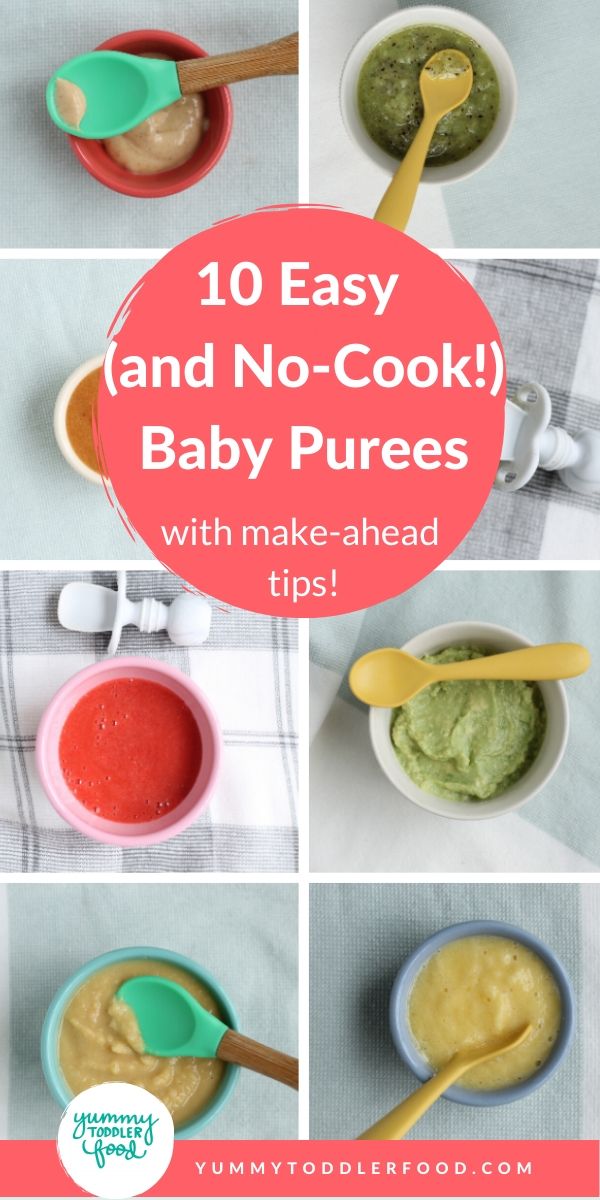
Learn how to make the EASIEST homemade baby food recipes (stage 1) for your little one with these super simple no-cook ideas. Plus: I have the best tips for making them ahead and freezing them so you can batch cook and simplify your days!
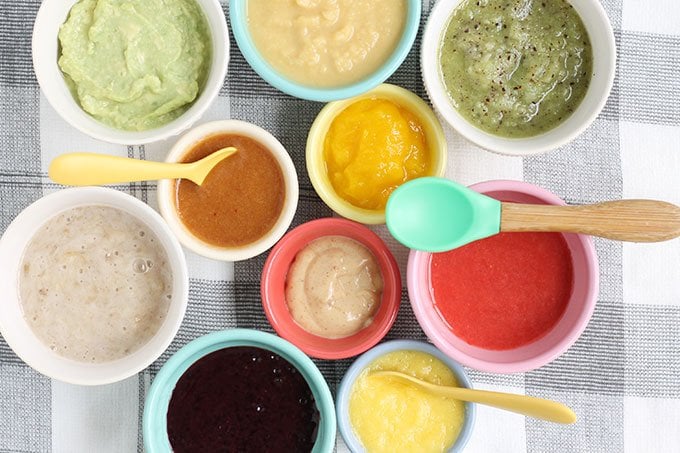
Homemade Baby Food
As a mom to three kids, I know firsthand how the urge to make homemade baby food can be both exciting and a little daunting. And if you have a busy schedule or other kids in the house, finding the time to actually do it can seem impossible. But, there are so many healthy foods that you can transform into stage 1 baby food purees with hardly any work or special equipment at all!
TIP: I use a regular blender for all of these recipes, so you don't need to buy a special baby food maker unless you want to.
Baby Food Recipes for 6, 7, and 8 Month Old Babies
These homemade baby food ideas are designed for younger babies who are still eating thinner purees, but you can of course use them for older babies and toddlers too. Each can be served as is, or you can combine more than one together to create new flavors if you're feeling creative!
TIP: If you want to add fat or protein to any of these fruit or veggie purees, simply stir in a little whole milk yogurt, coconut cream, or Avocado Puree.
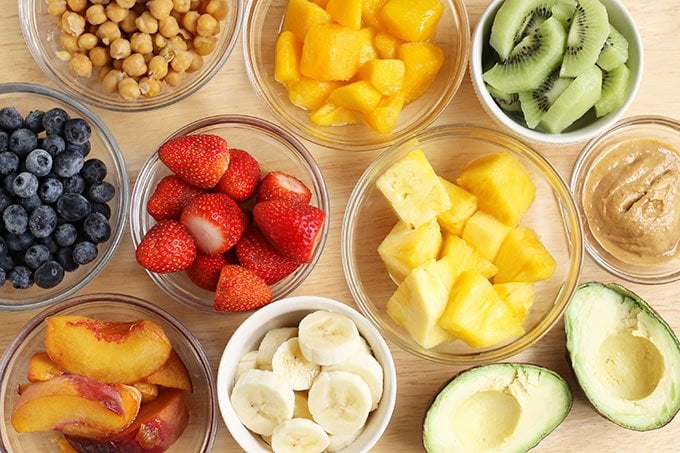
Best Way to Make Baby Food
I've found that the easiest and most approachable way to make baby food is to simply use a blender. With fresh ingredients and a little water, breastmilk, or formula to thin it as needed, you can easily make your baby meals without investing in equipment you may not use very long.
TIP: You'll want to start with at least 1 cup of any base ingredient to ensure that there's enough in the blender to fully blend up.
Tools You Need to Make Homemade Baby Food
To make these baby food recipes you'll need:
- Blender (you could also use an immersion blender if yours is very strong)
- Water, formula, or breastmilk to thin as needed
- Knife for chopping produce
- Spoon
- Bowls
- Ice cube tray
- Freezer bags for storage
- Baby food storage containers
Stage 1 Baby Food
These baby foods are meant for early eaters as they are typically very thin and easy for a baby to move around in their mouths. I follow the recommendations to wait until 6 months to start solids, so I personally don't worry excessively about this distinction as I like babies to experience some texture in their purees. (The ones you find at the store are low allergenic foods and are meant for 4+ months.)
Stage 2 Baby Food
These baby foods are typically a little bit thicker, sometimes include more than one ingredient, and offer a wider variety of ingredients. Most babies are ready for these sorts of purees around 7-8 months, or once they've mastered thinner purees. (Again, since I like to do a combined baby feeding approach with both baby led weaning and purees, I don't worry too much about following the calendar to decide when to introduce these.)
TIP: As a backup to my homemade baby foods, I love the options from Amara Organic Baby Food (paid affiliate link) since you simply need to stir it together with breast milk, formula, or water and it's ready to serve.
And now, for my ten go-to homemade baby food purees that you don't even need to cook!
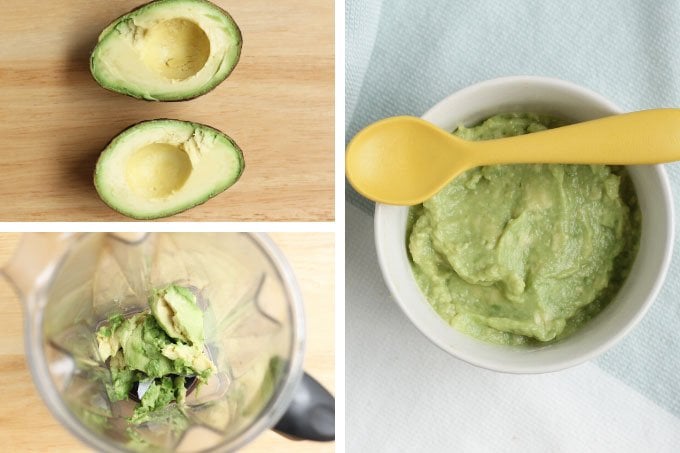
1. Avocado Puree
To make avocado puree for a baby, you just need a fresh avocado, a blender, and some lemon juice if you plan to store it for later. I sometimes even do this with just a fork if the avocado is super soft! It's a perfect way to introduce a low allergenic food that's rich in healthy fats.
TIP: Get the full recipe for Avocado Puree here.
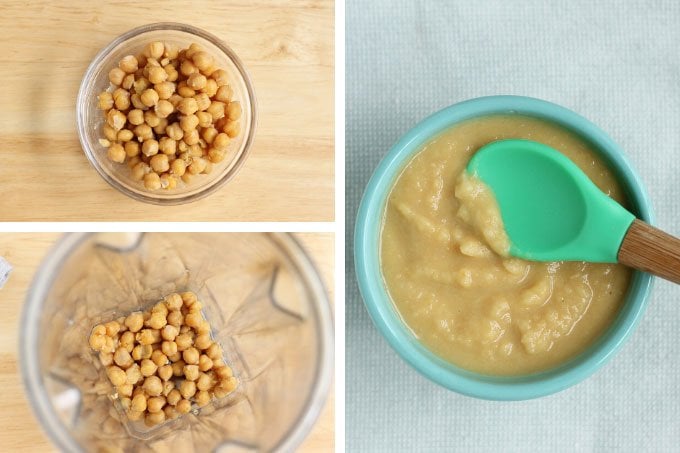
2. Bean Puree
Baby's early foods don't have to be all one food group and beans are a great food to have in the mix. You can do this easy bean puree with chickpeas, pinto beans, black beans, or even white beans, thinning it as needed with water, formula, or breastmilk. This is a great puree to mix with a little sweet potato or butternut squash.
TIP:Get the full recipe for Bean Puree here.
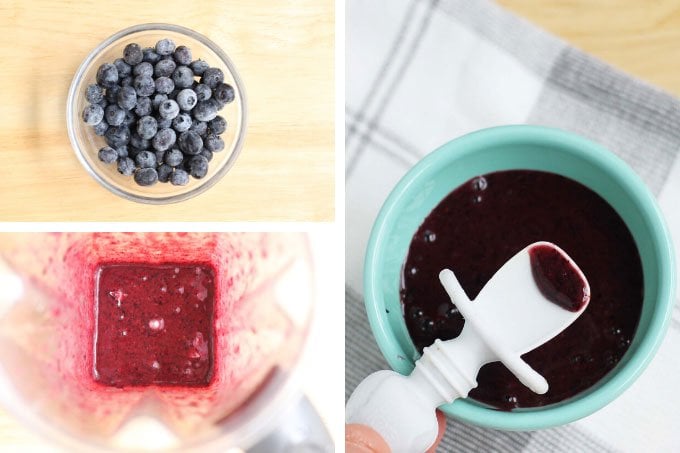
3. Blueberry Puree
Using fresh or frozen blueberries, this easy berry puree is loaded with fresh flavor and antioxidants. It's delicious on its own or stirred into plain whole milk yogurt or baby oatmeal. (Note that it thickens up as it sits in the fridge, so you'll need to stir it well to serve.)
TIP: Get the full recipe for Blueberry Puree here.
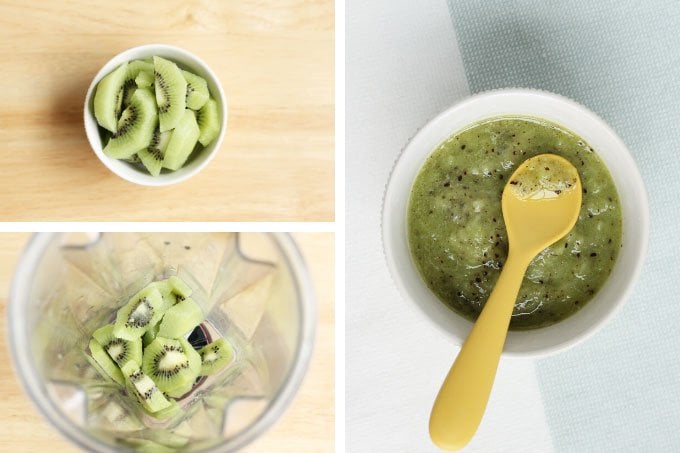
4. Kiwi Puree
With a bright flavor, this puree is great for babies who seem to love flavor—and it's a fun one to make and store for later. You'll want to make sure that you choose very ripe and sweet kiwi and taste it before you make the puree to ensure that it's not too tart. (If it seems tart, you can mix with banana or applesauce.)
TIP:Get the full recipe for Kiwi Puree here.
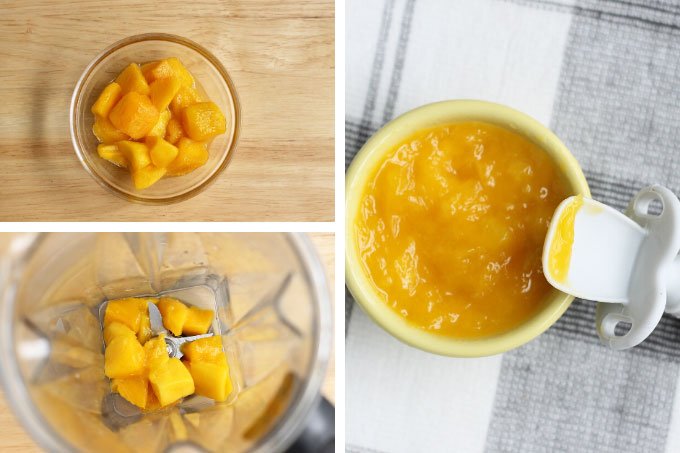
5. Mango Puree
Using fresh or thawed frozen mango, this baby puree blends up in seconds. It's bright, flavorful, and a great source of immune-boosting vitamins. Taste your mango to be sure that it's sweet and not too tart. (If it's tart, you can add Applesauce or ripe Banana Puree.)
TIP: Get the full recipe for Mango Puree here.
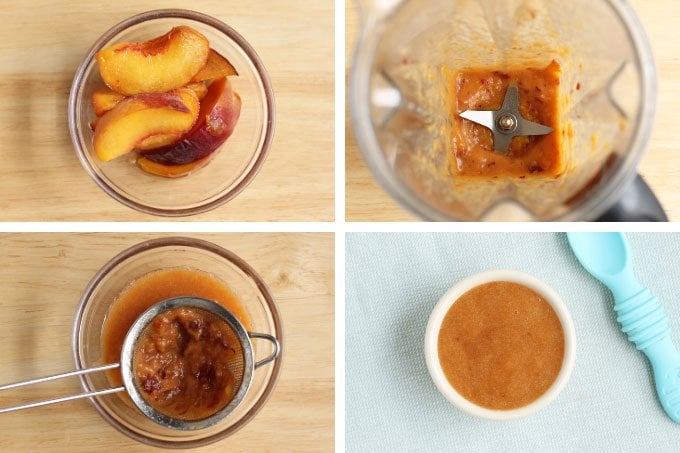
6. Peach Puree
Turn fresh or frozen and thawed peach slices into a super smooth Stage 1 baby food with this easy blender method. You'll want to strain out the skin since it's hard to blend up smooth, even with a high powered blender, but that's so easy to do! This baby food recipe is a nice alternative to applesauce.
TIP: Get the full recipe for Peach Puree here.
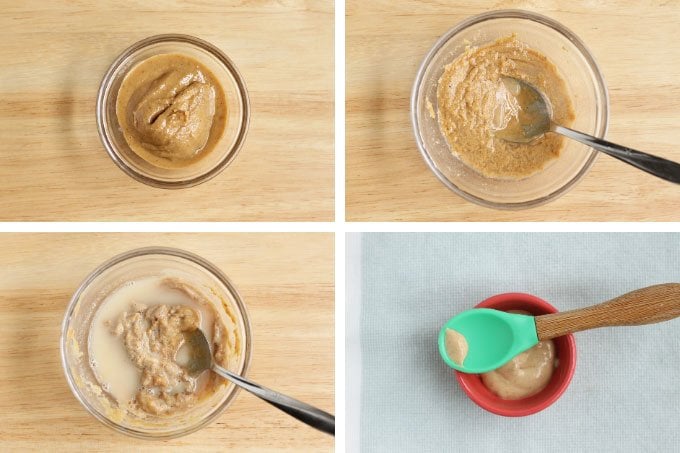
7. Whipped Peanut Butter
This may not have occurred to you, but whipped peanut butter is a great baby food! This is a perfect way to introduce baby to peanut butter and to offer it safely there after. You just need to stir water into unsweetened creamy peanut butter until it forms a whipped consistency like yogurt. It's smooth, not too sticky, and packed with protein.
TIP: Get the full scoop on introducing peanuts to baby here.
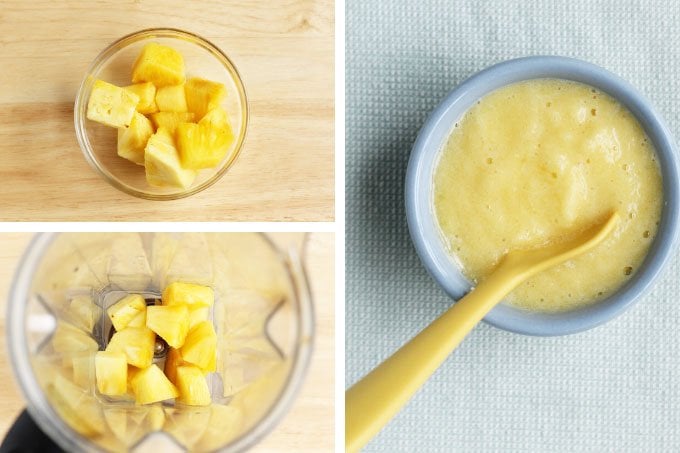
8. Pineapple Puree
Blend up fresh or frozen pineapple chunks into a tropical baby food puree that's smooth and creamy. This is yummy on its own or paired with whole milk plain yogurt. Taste your pineapple to ensure that it's not too tart. (If it's tart, you can add Applesauce or ripe Banana Puree.)
TIP: Get the full recipe for Pineapple Puree here.
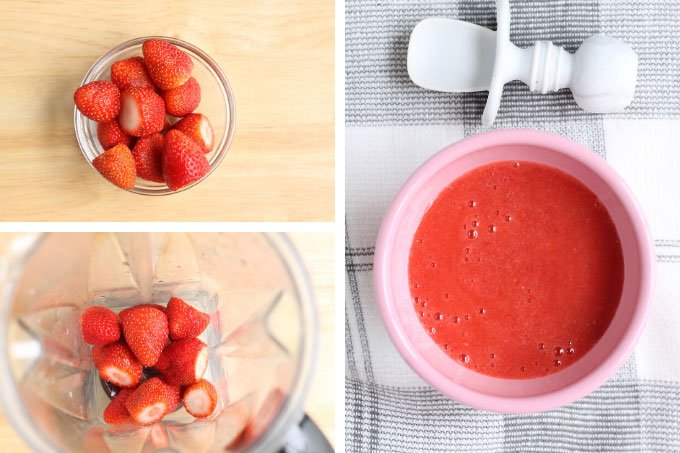
9. Strawberry Puree
Fresh strawberries blend up into a perfectly smooth homemade puree without the need for any additional liquid. You can serve this as is, or mix with applesauce if desired. The flavor of your berries will determine the flavor of your puree, so be sure to taste them for sweetness.
TIP: Get the full recipe for Strawberry Puree here.
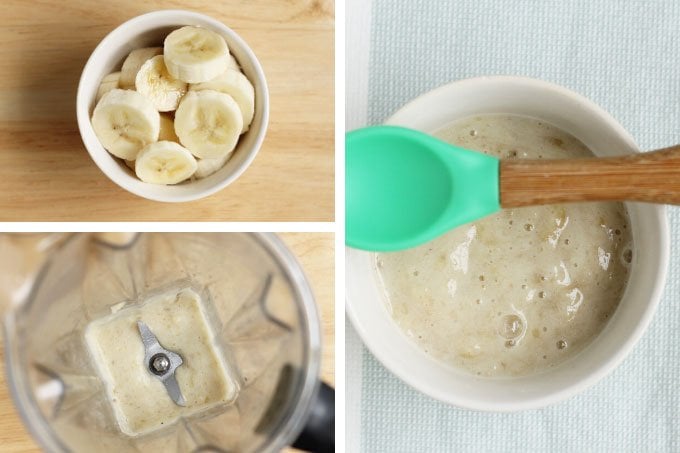
10. Banana Puree
Ripe bananas make great homemade baby food with the help of just a blender. This is a super simple baby food to make at home and it's easy to digest as a Stage 1 baby food. Use ripe bananas with brown spots to ensure that the puree tastes sweet and is easy for baby to digest.
TIP: Get the full recipe for Banana Puree here.
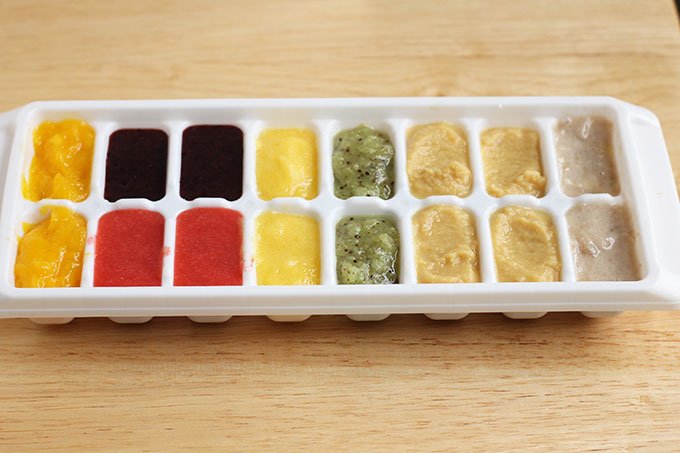
Homemade Baby Food Storage
The easiest way to store homemade baby food is to add fresh purees to an ice cube tray and freeze. Once frozen, simply pop out the cubes and store in labeled freezer bags for up to 3 months. These are a perfect way to make it easy to send homemade baby food to daycare or to simply get ahead for the coming week.
TIP: Find more information about storing baby food—including the best small food storage containers—here.
]
Tips for Making the Best Homemade Baby Food
- Use at least 1 cup base ingredient to ensure that a blender has enough volume to blend well.
- Thin any homemade puree with water, formula, or breast milk.
- Freeze any baby food you won't use within 3 days in an ice cube tray. Transfer frozen cubes into freezer storage bags for up to 3 months. Thaw these frozen baby food recipes in an airtight container in the fridge overnight before you plan to serve.
- Taste all fresh foods for sweetness and to ensure that your puree isn't too tart. To tame tartness, mix any puree with Banana Puree , Avocado Puree, Applesauce, or Mashed Sweet Potato.
- If you want to add fat or protein to any of these fruit or veggie purees, simply stir in a little whole milk yogurt, coconut cream, or Avocado Puree.
- Use breastmilk or formula in place of the water if desired.
- Mix two purees together for more complex flavors.
- Add texture to any puree by stirring in baby oatmeal or hemp seeds.
- For more details on each of these, find them here: Avocado Puree; Banana Puree, Bean Puree; Blueberry Puree, Kiwi Puree, Mango Puree, Pineapple Puree, Peanut Butter Puree, Peach Puree, Strawberry Puree
I'd love to hear your feedback on this way of making simple baby food, so please comment below. I so appreciate hearing your experience with my recipes!

10 No-Cook Homemade Baby Food Recipes
You'll choose ONE ingredient to blend up—a fruit, a veggie, or beans. See the list below. You can make enough for a few days or make a double batch to freeze more baby food for future weeks. The nutrition information will vary based on which ingredients you use.
Prep Time 5 mins
Cook Time 0 mins
Total Time 5 mins
Course Baby Food
Cuisine American
Servings 4
Calories 42 kcal
- 1 cup blueberries, diced strawberries, diced peaches (peeled), diced kiwi (peeled), diced pineapple (peeled), diced banana (peeled), diced mango (peeled), diced avocado (peeled), OR beans (rinsed and drained)
- water, formula, or breast milk (as needed)
-
Choose one fruit, the avocado, or beans and add to a blender.
-
If making the puree with blueberries, strawberries, peaches, kiwi, pineapple, mango, or beans, add ¼ cup water and blend, adding more water as desired to make a thin, very smooth puree. If making avocado or banana, just blend (without water) until very smooth.
-
Serve or store in an airtight container for 3-5 days in the fridge, or up to 3 months in the freezer.
- Use at least 1 cup base ingredient to ensure that a blender has enough volume to blend well.
- Thin any homemade puree with water, formula, or breast milk.
- Freeze any baby food you won't use within 3 days in an ice cube tray. Transfer frozen cubes into freezer storage bags for up to 3 months. Thaw these frozen baby food recipes in an airtight container in the fridge overnight before you plan to serve.
- Taste all fresh foods for sweetness and to ensure that your puree isn't too tart. To tame tartness, mix any puree with Banana Puree , Avocado Puree, Applesauce, or Mashed Sweet Potato.
- If you want to add fat or protein to any of these fruit or veggie purees, simply stir in a little whole milk yogurt, coconut cream, or Avocado Puree.
- Use breastmilk or formula in place of the water if desired.
- Mix two purees together for more complex flavors.
- Add texture to any puree by stirring in baby oatmeal or hemp seeds.
- For more details on each of these, find them here: Avocado Puree; Banana Puree, Bean Puree; Blueberry Puree, Kiwi Puree, Mango Puree, Pineapple Puree, Peanut Butter Puree, Peach Puree, Strawberry Puree
Serving: 0.25 cup Calories: 42 kcal Carbohydrates: 11 g Protein: 1 g Fat: 1 g Saturated Fat: 1 g Polyunsaturated Fat: 1 g Monounsaturated Fat: 1 g Sodium: 1 mg Potassium: 57 mg Fiber: 2 g Sugar: 7 g Vitamin A: 40 IU Vitamin C: 7 mg Calcium: 4 mg Iron: 1 mg
Keyword baby food, baby food recipes, homemade baby food
Rate in the comments and tag @yummytoddlerfood on IG!
Filder Under:Baby Food, Egg-Free, Gluten-Free, Recipes, Starting Solids, Vegetarian
How to Make Food for 6 Month Baby
Source: https://www.yummytoddlerfood.com/homemade-baby-food/
0 Response to "How to Make Food for 6 Month Baby"
Post a Comment